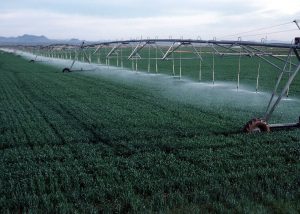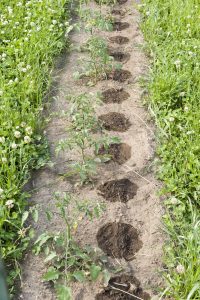Guest Co-Author: Deborah M. Hamlin, CEO, Irrigation Association
 Pivot irrigation systems are one example of irrigation technology at work.
Pivot irrigation systems are one example of irrigation technology at work.
Leonardo da Vinci once said, “Water is the driving force of all nature.” It is amazing how this statement from the 15th century holds even truer today. As we celebrate July as Smart Irrigation Month, it is important to reflect on agricultural water use and what it means to our society.
At the Foundation for Food & Agriculture Research (FFAR) and the Irrigation Association (IA), we recognize that U.S. agriculture uses a lot of water. This is a simple statement right? Well, not really. To some, this is unacceptable; to others it is a way of life. Regardless of where you fall on this spectrum, if we want our future generations to have a safe and reliable food supply, we have big challenges ahead.
According to the USDA, the United States has more than 55 million acres of farmland irrigated. Agricultural water use accounts for 80 percent of the nation’s consumptive water use.
 Drip irrigation enables precise water application on-farm. Photo: Dwight Sipler
Drip irrigation enables precise water application on-farm. Photo: Dwight Sipler
No one questions the importance of water management – we all enjoy getting fresh, clean water from our faucets – but how we manage water use in agriculture means a lot to our society, health and environment. As the global population grows and consumes more goods, such as food, clothes and even electronics, coupled with changes in our climate, such as extreme droughts and flooding, our society will push water resources and agricultural production to their limits.
How are we going to meet these challenges? This is where FFAR and the IA are excited to work together. The mission of the IA is quite simple: promote efficient irrigation. At FFAR, we see the potential that research to advance efficient irrigation brings to the long-term sustainability and productivity of our agricultural system. The opportunities for farmers to implement these new and innovative irrigation technologies and practices are limitless and we are energized by the speed at which today’s farming community adopts new technology. Just as we have seen advancements in computing and cellular technologies over the past ten years, the advancements in irrigation technologies over this same period are both astonishing and exciting.
As farmers are the first line defenders and stewards of our nation’s natural resources, our organizations are committed to not only advancing and promoting these technologies and practices, but also working with farmers and ranchers to develop solutions to water scarcity, allowing farmers to maximize productivity while not wasting a drop of water.
“Doing more with less” is the marching order we have moving forward. This July…this Smart Irrigation Month…let’s all look for new ways to work together to make sure the water we have goes a long way for everyone.